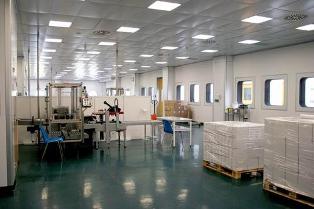Lighting calculation methods
The lighting calculation can determine:
-
 dumping power required to obtain a given illumination for the chosen type, location and number of luminaires,
dumping power required to obtain a given illumination for the chosen type, location and number of luminaires, -
the number and location of lighting fixtures necessary to obtain a given illumination for the selected type of lighting fixtures and the power of the lamps in them,
-
estimated illuminance for a known type, location of lamps and lamp power in them.
The main tasks in the design are the tasks of the first type, since the type of lamps and their location must be selected based on the quality of the lighting and its efficiency.
Solving problems when calculating lighting of the second type is carried out if the power of the lamps is precisely set, for example, it is necessary to use lamps with 80 W fluorescent lamps.
Tasks of the third type are solved for existing installations if the illuminance cannot be measured and for project checks and calculations, for example, for point method verification, calculations performed using the utilization factor method.
Lighting calculations are possible using the following methods:
1) by the method of the coefficient of use of the luminous flux,
2) by the specific power method,
3) by point method.
Method of degree of use Used to (calculate the total uniform illumination of horizontal surfaces with lighting fixtures of any type.
Specific power supply method It is used to approximately predetermine the installed power of the lighting installation.
Point method for calculating lighting It is used to calculate general uniform and localized lighting, local lighting, regardless of the location of the illuminated surface with direct lighting fixtures.
In addition to the above methods for calculating lighting, there is a combined method that is used in cases where the utilization factor method is not applicable and the lighting fixtures do not belong to the class of direct light.
For some types of rooms (corridors, stairs, etc.) there are direct standards that determine the power of the lamp for each such room.
Consider the computational methodology for each of the described methods.
A method of using light flux
As a result of the solution, according to the method of utilization of the luminous flux, the luminous flux of the lamp is established, according to which it is selected from among the standard ones. The flux of the selected lamp should not differ from the calculated one by more than +20 or -10%. If the discrepancy is greater, the target number of luminaires is adjusted.
Calculation equation for determining the required luminous flux of one lamp:
F = (Emin NS C NS x NSz) / (n NS η)
where F — luminous flux of the lamp (or lamps) in the lamp, lm; Emin — standardized lighting, luxury, ks — safety factor (depends on the type of lamps and degree of pollution of the room), z — correction factor, taking into account that the average illuminance in the room is greater than the standardized minimum, n — the number of lamps (lamps), η — the coefficient of use of the luminous flux, equal to the ratio of the luminous flux falling on the working surface to the total flux of all lamps; S is the area of the room, m2.
Degree of use of the luminous flux — a reference value, depends on the type of lighting fixture, the parameters of the room (length, width and height), the reflection coefficients of the ceilings, walls and floors of the room.
The procedure for calculating lighting by the method of the coefficient of use of the luminous flux:
1) the calculated height No is determined, type and number of lighting fixtures in a room.
The estimated height of the suspension of the light fixture is determined based on the geometric dimensions of the room
3p = H — hc — hp, m,
where H is the height of the room, m, hc — the distance of the lighting fixture from the ceiling (the "overhang" of the lighting fixture is taken in the range from 0, when the lighting fixtures are installed on the ceiling, to 1.5 m), m, hp is the height of the working surface above the floor (usually хp = 0.8 m).
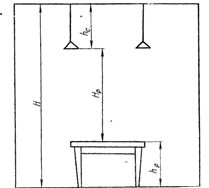
Rice. 1. Determination of the design height when calculating electric lighting
For more information on determining the design height, see here: Placement of lighting fixtures in the room when calculating the lightingI am
2) according to the tables there are: safety factor kcorrection factor z, normalized illumination Emin,
3) the index of the room i is determined (takes into account the dependence of the coefficient of use of the luminous flux on the parameters of the room):
i = (A x B) / (Hp x (A + B),
where A and B are the width and length of the room, m,
4) the degree of use of the luminous flux of the lamps η depending on the type of lighting fixture, the reflectivity of the walls, ceiling and work surface ρc, ρHC, ρR;
5) the required flux of one lamp is found by the formula F;
6) a standard lamp with a similar luminous flux is selected.
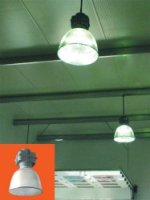
n = (Emin NS C NS x NSz) / (F NS η)
Specific power supply method
The specific installed power is the ratio of dividing the total installed power of the lamp in our room by the area of the room:
studs = (Strl x n) / S
where strud — specific installed power, W / m2, Pl — lamp power, W; n- the number of lamps in the room; S is the area of the room, m2.
Specific power is a reference value.In order to correctly choose the value of the specific power, it is necessary to know the type of lighting fixtures, the normalized lighting, the safety factor (for its values that differ from those indicated in the tables, proportional recalculation of the specific power, the permissible power values), reflection coefficients of the surfaces of the room, the values of the design height and the area of the room...
Calculated equation for power determination° Seat lamp:
Pl = (strud x C) / n
The procedure for calculating lighting using the specific power supply method:
1) the calculated height No, the type and number of lamps and in the room are determined;
2) the tables show the normalized lighting for this type of premises Emin, specific power strudari;
3) the power of one lamp is calculated and the standard one is selected.
If the calculated lamp power turns out to be greater than that used in the accepted luminaires, the required number of luminaires must be determined by taking the value of the lamp power in the luminaire RL.

Point method for lighting calculation
This method is used to find the lighting at any point in the room.
Procedure for calculating point light sources:
1) The calculated height is determined Зp, type and placement in the lighting fixtures in the room and a plan of the room with lighting fixtures is drawn to scale,
2) the control point A is applied to the plan and the distances from the projections of the lamps to the control point — d are found;
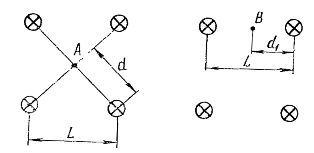
Rice. 2. Location of the control point A when placing bodies in the corners of the square and B on the sides of the rectangle
3) the illumination e from each lighting unit is found from the spatial isoluxes of the horizontal lighting;
4) the total conditional illuminance from all lamps ∑e is found;
5) the horizontal illumination from all lighting fixtures at point A is calculated:
Ea = (F x μ / 1000NS ks) x ∑e,
where μ — coefficient that takes into account the additional lighting from distant lighting fixtures and the reflected light flux, кс — safety factor.
Instead of spatial isolux of conditional horizontal illuminance, it is possible to use tables of horizontal illuminance values with a conditional discharge of 1000 lm.
The order of the scoring method for the glowing streaks:
1) the calculated height Зp, the type of lamps and fluorescent lamps in them, the placement of lamps in the strip and strips in the room are determined. The stripes are then applied to the floor plan, drawn to scale;
2) control point A is applied to the plan and the distances from point A to the projection of the streams are found. According to the floor plan, the length of half of the strip is found, which is usually indicated in the point method by L. It should not be confused with the distance between the strips, also indicated by L and determined by the most advantageous ratio (L / Hp);
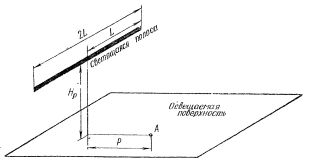
Rice. 3. Scheme for calculating the illumination by the point method using strips of lighting fixtures
3) the linear density of the light flux is determined
F '= (Fsv x n) / 2L,
where Fсв — luminous note of the lamp, equal to the sum of light fluxes from lamps, lamps; n- the number of lighting fixtures in the lane;
4) are the given dimensions p '= p /HP, L '= L /Hp
5) according to graphs of linear isoluxes of relative illumination for fluorescent lamps (luminous stripes) is for each half-strip, depending on the type of luminaire p 'and L'
Ea = (F ‘ x μ / 1000NS ks) x ∑e

